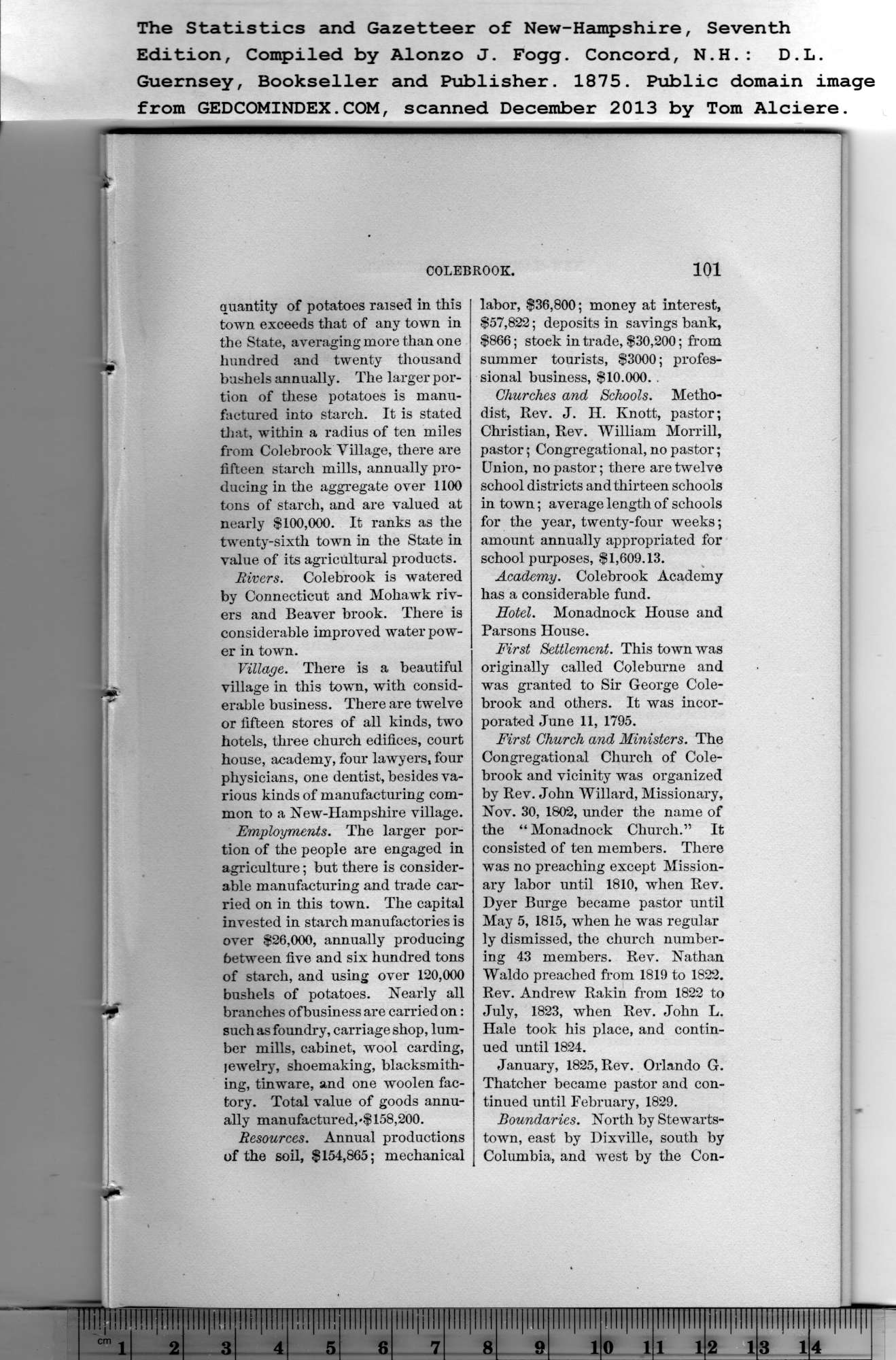|
quantity of potatoes raised in this
town exceeds that of any town in
the State, averaging more than one
hundred and twenty thousand
bushels annually. The larger por-
tion of these potatoes is manu-
factured into starch. It is stated
that, within a radius of ten miles
from Colebrook Village, there are
fifteen starch mills, annually pro-
ducing in the aggregate over 1100
tons of starch, and are valued at
nearly $100,000. It ranks as the
twenty-sixth town in the State in
value of its agricultural products.
Rivers. Colebrook is watered
by Connecticut and Mohawk riv-
ers and Beaver brook. There is
considerable improved water pow-
er in town.
Village. There is a beautiful
village in this town, with consid-
erable business. There are twelve
or fifteen stores of all kinds, two
hotels, three church edifices, court
house, academy, four lawyers, four
physicians, one dentist, besides va-
rious kinds of manufacturing com-
mon to a New-Hampshire village.
Employments. The larger por-
tion of the people are engaged in
agriculture; but there is consider-
able manufacturing and trade car-
ried on in this town. The capital
invested in starch manufactories is
over $26,000, annually producing
between five and six hundred tons
of starch, and using over 120,000
bushels of potatoes. Nearly all
branches ofbusiness are carried on:
such as foundry, carriage shop, lum-
ber mills, cabinet, wool carding,
jewelry, shoemaking, blacksmith-
ing, tinware, and one woolen fac-
tory. Total value of goods annu-
ally manufactured,*$158,200. |
Resources. Annual productions
of the soil, $154,865; mechanical
labor, $36,800; money at interest,
$57,822; deposits in savings bank,
$866; stoek in trade, $30,200; from
summer tourists, $3000; profes-
sional business, $10,000. .
Churches and Schools. Metho-
dist, Rev. J. II. Knott, pastor;
Christian, Rev. William Morrill,
pastor; Congregational, no pastor;
Union, no pastor; there are twelve
school districts and thirteen schools
in town; average length of schools
for the year, twenty-four weeks;
amount annually appropriated for
school purposes, $1,609.13.
Academy. Colebrook Academy
has a considerable fund.
Hotel. Monadnock House and
Parsons House.
First Settlement. This town was
originally called Coleburne and
was granted to Sir George Cole-
brook and others. It was incor-
porated June 11, 1795.
First Church and Ministers. The
Congregational Church of Cole-
brook and vicinity was organized
by Rev. John Willard, Missionary,
Nov. 30, 1802, under the name of
the “Monadnock Church.” It
consisted of ten members. There
was no preaching except Mission-
ary labor until 1810, when Rev.
Dyer Burge became pastor until
May 5, 1815, when he was regular
ly dismissed, the church number-
ing 43 members. Rev. Nathan
Waldo preached from 1819 to 1822.
Rev. Andrew Rakin from 1822 to
July, 1823, when Rev. John L.
Hale took his place, and contin-
ued until 1824.
January, 1825, Rev. Orlando G.
Thatcher became pastor and con-
tinued until February, 1829.
Boundaries. North by Stewarts-
town, east by Dixville, south by
Columbia, and west by the Con- |
